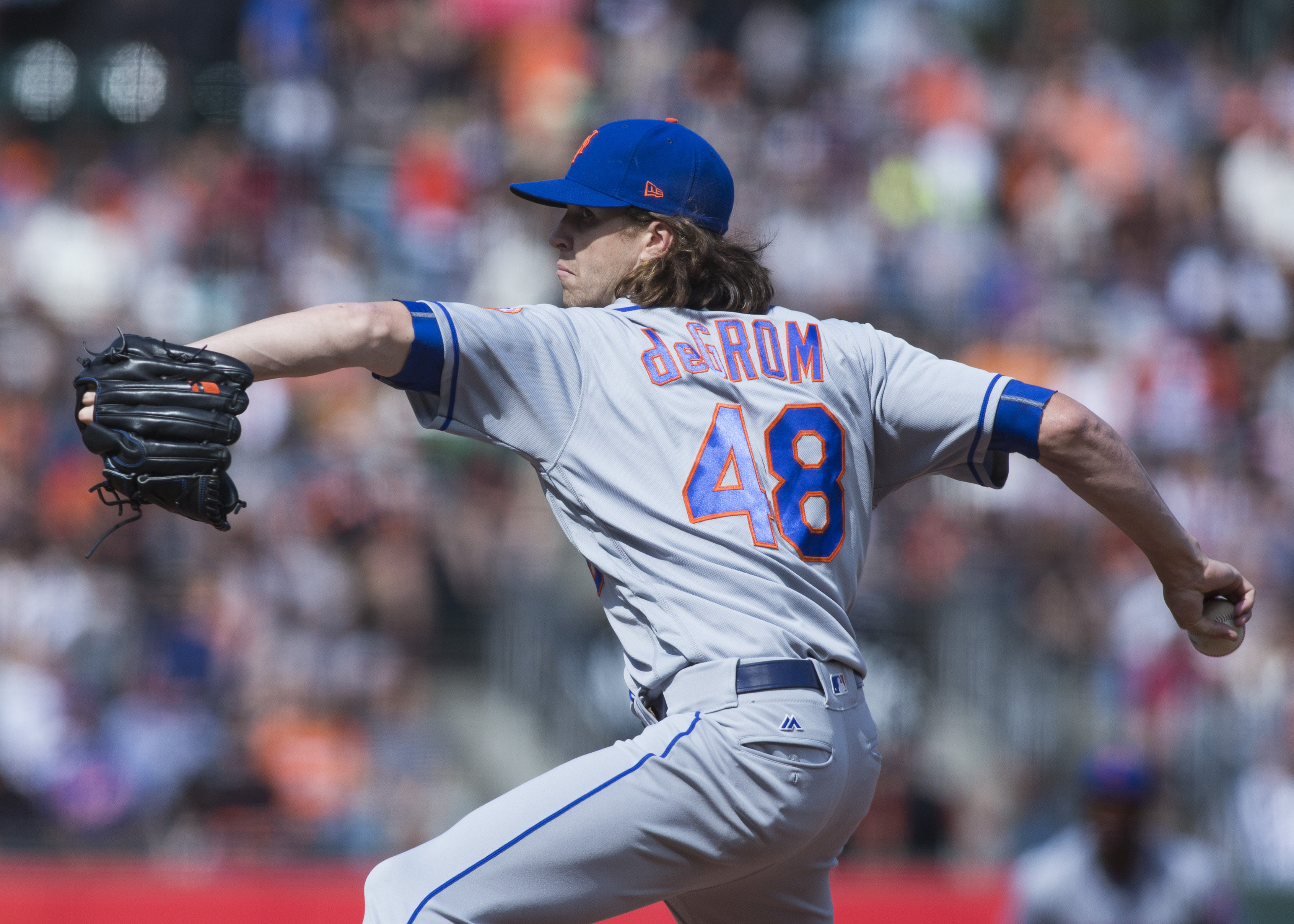Jacob deGrom entered Saturday’s game against the Giants striking out more batters than ever before, but most metrics place this as his worst season with the Mets. How can both of these things be true? It’s not just an issue of deGrom having two bad starts and then being an ace during his last three outings. I think one at-bat from the Mets’ 5-2 win explains a lot.
It was the bottom of the sixth. The Mets led 1-0 thanks to Johnny Cueto throwing a batting practice fastball to Wilmer Flores. Even in San Francisco, the ball can carry out to left in 2017. deGrom knew this when he was facing Buster Posey with a runner on base. He threw a fastball away, then a two-seamer well outside. Since the Giants don’t have bunch behind Posey, deGrom went with a changeup that tailed over the zone instead of giving in. Then he went with a slider out of the zone for a swinging strike two, and fastballs away until Posey hit a weak fly to right.
deGrom never tried to jam Posey, going for the strikeout. He had plenty in the tank for the third time through the lineup, because he wasn’t going for the perfect pitch all game long. (Think about how much the Mets’ younger pitchers nibble with breaking balls.) It’s not like deGrom threw perfect pitches in this at-bat. The 1-0 pitch wasn’t close and the 2-0 pitch was an elevated changeup! What he seemed to be doing, instead, was exert control over what kind of mistake he could possibly make. If he was going to screw up, he’d walk Posey rather than giving up an extra-base hit.
Early in the season it looked like deGrom was trying to strike everyone out. When you have the Mets’ infield behind you…yeah, I’d try to rely on the strikeout too. The problem is that when he couldn’t get swings and misses, he was giving up more walks and home runs. On Saturday, it looked like deGrom would be fine with weak contact for most of the game. Keep the pitch count low, eat up innings. After all, San Francisco doesn’t have much power and their park is one of the hardest to hit home runs in. Pitching to contact is much more viable there.
deGrom’s stuff is good enough that he’ll get swings and misses even when he isn’t trying to throw the ball past the hitter every time. He got seven strikeouts over eight innings of work, while only giving up one run, one walk, and four hits. Saturday’s game seemed like part of a pattern. deGrom’s whiff percentage has dropped from 16.6 percent in the first two months of the season to 13.1 percent in June, and now he’s had his three most efficient starts of the season.
Of course, the Mets needed runs to win. Thankfully, San Francisco’s bullpen got involved in the eighth. Sam Dyson – who should remind everyone not to overpay for a “proven closer” – came in and served up a meatball for a Curtis Granderson leadoff triple. Asdrubal Cabrera walked. Yoenis Cespedes whiffed on an elevated slider that missed so much it was good. Bruce Bochy turned to a left-handed reliever, but with runners at the corners and one out he kept the infield in traditional double-play position. Jay Bruce reached out for a fastball and pulled it past the unshifted infield to give the Mets the lead. (If there was a shift, Bruce hits it right in to the deep second base spot.) Flores doubled down the line to tack on another run. The Mets tacked on two more in the ninth to survive a somewhat shaky inning from Addison Reed.
Does This Help My Trade Value?
Asdrubal Cabrera went two-for-three, doubled, walked twice, and made a good diving play moving to his left from his new second base position. Someone may want to tell him the impending free agent market will like him more if he’s open to playing multiple positions
What’s Next?
The Mets try to demonstrate the difference between frustrating baseball teams and hopeless causes as they look to sweep the Giants.
Photo credit: Neville E. Guard – USA Today Sports
